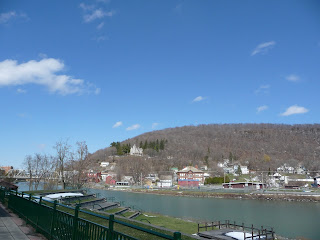When I was up north a couple of weeks ago I travelled past Inveravon church, and through Glenlivet and Tomintoul to Aberdeen. Two days later I was accompanied by cousin Kathleen and Dad’s cousin Helen on a trip through the Cabrach to Glencorrie and Dufftown.
At Inveravon churchyard I wanted to see the gravestone that HDM referred to – that of William McWillie (who died in 1685) and his wife Katherine Gordon. The one that goes " Heir lyes ane honest man called William McWillie, who livid in the Cories, who departed the 10 of June, 1685 ; and Ketren Gordene, his spouse." I was disappointed that I couldn’t find it, but very interested to meet a lady called Tricia Lawson who has lived close by the church for some 40 years. She knows a lot about the history of the church and the area, and told me that she also had heard of this very stone (from a former minister there) but did not know where it is - or was. She also had heard that the stone had been carried there by the McWilliams. She pointed out that the present church building dates from about 1806 and that it is positioned directly over part of the original graveyard. Tricia has said she will get in touch if she ever finds out any more about the story of this stone.
Here is a photo of the church as it is today.
By the way Tricia pointed out the location of Delgarvan to me (where it seems that our Lewis McWilliam originated) – on a bend in the Spey about a mile or so north of the church, but she was able to tell me that there is nothing much left there now after the remains of the buildings were flattened for road-building in the 1960s.
From the church I drove up through Glenlivet to Tomnavoulin (near the Corries farm once inhabited by McWillie alias McWilliam families) before heading on to Aberdeen for Laura’s birthday meal. I didn’t have time to linger long, but stopped to take these photos of the old packhorse bridge at Bridgend and of this fine bull guarding the road up to Easter Corrie.
We had a fine day for our journey through the Cabrach to Dufftown on the Sunday – myself + Helen and Kathleen, and Kathleen’s husband Eddie. Helen was a Dufftown quine and knew Glencorrie in her youth – the home of her mother and various uncles, aunts and cousins. We drove up to the farm and took a short wander round the house, the two cottages and various outbuildings. It is still very much a working farm, but the present occupants seem also to run a business contracting out farm equipment – such as two big combine harvesters.
We didn’t meet the occupants, but we took a couple of pictures – the farmhouse, and the two cottages – one of which would have been the boyhood home of my father.
Helen remembered that they used to have music and dancing in the loft of one of the barns. I can picture the scene in my mind, but the building is stripped to a functional minimum these days.
After a light lunch in a Dufftown cafe, we had a wander round the graveyard at Mortlach church - a fine old and historic place.
There are at least three generations of our ancestors there (in fact four generations in my case), and I attach here photos of the gravestones.
Finally there is another stone here which took our interest. It isn’t in memory of a McWilliam, but a Moir. I was really quite surprised to see wording which was very similar to that on the stone that HDM described at Inveravon – and of course it is of a very similar age. Here is a photo and a transcription.
“Heir lyes ane honest man called John Moir Husband to Elspet Reid who was killed in the defence of his own property at Walk Miln of Bolvenie the 13 day of October 1660. Memento Mori”
I conclude from this, and a few other such inscriptions I have come across in recent weeks that this form of wording seems to have been quite common in the 17th century.
And as a footnote, here is me with the statue of an Aberdeen Angus bull – on the outskirts of Alford on the return journey to Aberdeen.

















































